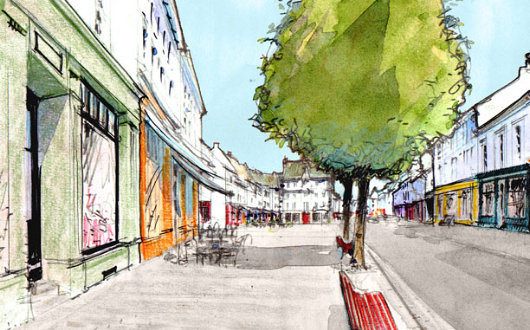
About Andrew Cusack
 Writer, web designer, etc.; born in New York; educated in Argentina, Scotland, and South Africa; now based in London.
Writer, web designer, etc.; born in New York; educated in Argentina, Scotland, and South Africa; now based in London. read more
News
Blogs
Reviews & Periodicals
Arts & Design
World
France
Mitteleuropa
Knickerbockers
Argentina
The Levant
Africa
Cape of Good Hope
Netherlands
Scandinavia
Québec
India
Muscovy
Germany
Academica
A New Scots Town in the Highlands
The 20th Earl of Moray teams up with Miami-based firm Duany Plater-Zyberk to plant a New Town of 10,000 inhabitants outside Inverness

BELEIVE IT OR not, Inverness is one of the fastest-growing cities in Europe, and a local landowner, the 20th Earl of Moray, has teamed up with Duany Plater-Zyberk, an American firm known for its traditional architecture and urbanist ideas, to help create a sustainable new town of 10,000 inhabitants near the “Capital of the Highlands”. Tornagrain will rest on a 200-hectare (500-acre) site on the A96 corridor between Inverness and Nairn. Much of the recent growth in the Highlands has been poorly managed, raising concerns of suburban sprawl and poor land management. Moray Estates, the land holding company of the Earl of Moray (pronounced ‘Murry’) has decided to take the lead by planning a new town in the best tradition of Scottish architecture and urban development.

If, as predicted, the Inverness area is to increase in population by over 30,000, Tornagrain will be able to accommodate one-third of that increase on a relatively small footprint, allowing for much of the natural beauty of the area to be maintained instead of over-developed. The town will feature a High Street (that’s ‘Main Street’ to Americans) and town center functioning as a nucleus for smaller neighbourhoods with appropriately sized green spaces.

In the town center, parking will be available in internal courts so that the town streets can remain focused on the inhabitants rather than their parked transport. Tornagrain is also ideally sited for transportation purposes, located next to the Aberdeen-to-Inverness railway line and with Inverness airport nearby providing air links to the rest of Britain and Europe.

The five thousand housing units will include flats, cottages, courtyard houses, terrace houses and mews units. Importantly, Moray Estates confirms that the architects of the new development are “looking to the Scottish vernacular for architectural inspiration”. Tornagrain will be a Scottish town that looks like a Scottish town, instead of a series of soulless boxes that could be planted anywhere in the world.

The predictable objections from the more ideological members of the architectural community, but the Earl of Moray is made of sterner stuff than to give in to the raised hackles of some taste-deprived modernists. While it’s in the short-term interest of quick-profit developers to put up ugly shacks, sell them, and “get outta Dodge” with the profits, the Earls of Moray have been in the neighbourhood for centuries, and (God willing) will stay there for centuries to come. Traditional architecture may incur a larger outlay at the beginning but is cheaper to maintain and more versatile in the long-run. What’s more, it sells better than bland pre-fab suburban units. Would that more property developers have the sense of this wise Scots aristocrat!

Search
Instagram: @andcusack
Click here for my Instagram photos.Most Recent Posts
- Silver Jubilee November 21, 2024
- Articles of Note: 11 November 2024 November 11, 2024
- Why do you read? November 5, 2024
- India November 4, 2024
- The Lithe Efficiency of the Old Constitution November 4, 2024
Most Recent Comments
Book Wishlist
Monthly Archives
Categories



Too bad the laird can’t preserve the culture of Tornagrain as well as its architecture.
You’ve missed a trick, Cusack: the Earl of Moray is not the only member of the European nobility involved in this project. Elizabeth Plater-Zyberck is a countess by birth, her family, of the Westphalian old nobility, and later of Courland and Livonia, were made Russian counts in 1774, the title being recognised in the 19th century by both Prussia and Austria.
None of this makes her a good architect of course, but her firm’s sketches are more than promising.
And her partner Andres Duany has expressed his pro-Franco sympathies in an interview once.
A countess and a Franco supporter? Sounds like we’ve found the official architectural firm of andrewcusack.com!
If the Earl keeps this up he just may find himself being elevated to marquess by old Prince Charles who has quite the love for just such things – see Poundbury. These great men just may save Ol’ England.